Xuehai Qian
Fine-Grained Embedding Dimension Optimization During Training for Recommender Systems
Jan 09, 2024



Abstract:Huge embedding tables in modern Deep Learning Recommender Models (DLRM) require prohibitively large memory during training and inference. Aiming to reduce the memory footprint of training, this paper proposes FIne-grained In-Training Embedding Dimension optimization (FIITED). Given the observation that embedding vectors are not equally important, FIITED adjusts the dimension of each individual embedding vector continuously during training, assigning longer dimensions to more important embeddings while adapting to dynamic changes in data. A novel embedding storage system based on virtually-hashed physically-indexed hash tables is designed to efficiently implement the embedding dimension adjustment and effectively enable memory saving. Experiments on two industry models show that FIITED is able to reduce the size of embeddings by more than 65% while maintaining the trained model's quality, saving significantly more memory than a state-of-the-art in-training embedding pruning method. On public click-through rate prediction datasets, FIITED is able to prune up to 93.75%-99.75% embeddings without significant accuracy loss.
RobustState: Boosting Fidelity of Quantum State Preparation via Noise-Aware Variational Training
Nov 27, 2023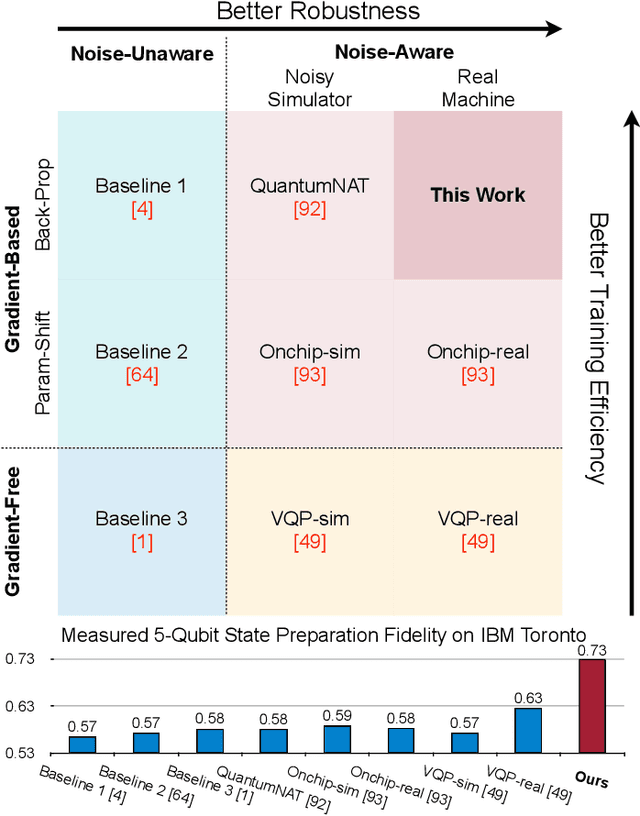
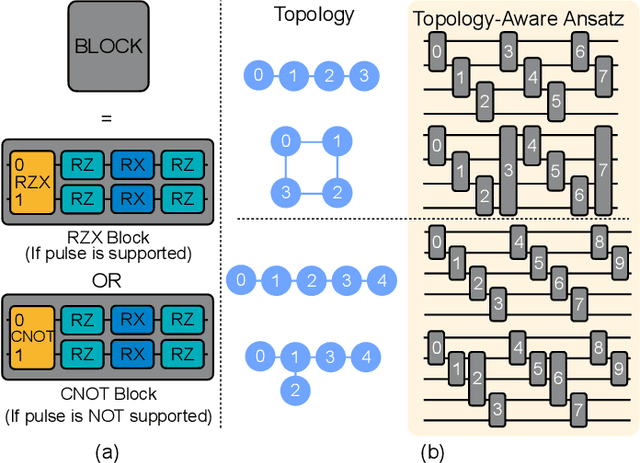
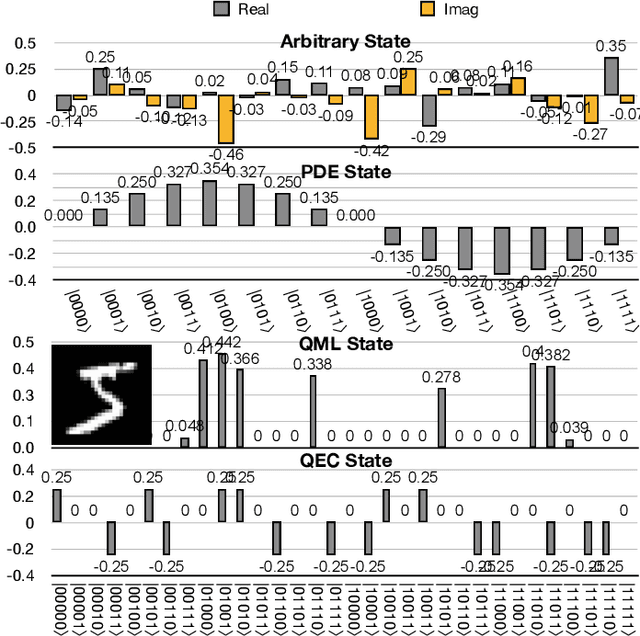
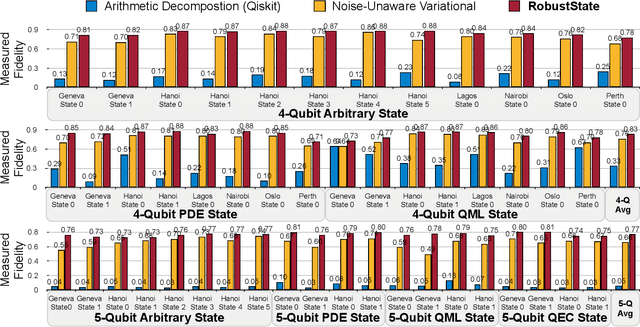
Abstract:Quantum state preparation, a crucial subroutine in quantum computing, involves generating a target quantum state from initialized qubits. Arbitrary state preparation algorithms can be broadly categorized into arithmetic decomposition (AD) and variational quantum state preparation (VQSP). AD employs a predefined procedure to decompose the target state into a series of gates, whereas VQSP iteratively tunes ansatz parameters to approximate target state. VQSP is particularly apt for Noisy-Intermediate Scale Quantum (NISQ) machines due to its shorter circuits. However, achieving noise-robust parameter optimization still remains challenging. We present RobustState, a novel VQSP training methodology that combines high robustness with high training efficiency. The core idea involves utilizing measurement outcomes from real machines to perform back-propagation through classical simulators, thus incorporating real quantum noise into gradient calculations. RobustState serves as a versatile, plug-and-play technique applicable for training parameters from scratch or fine-tuning existing parameters to enhance fidelity on target machines. It is adaptable to various ansatzes at both gate and pulse levels and can even benefit other variational algorithms, such as variational unitary synthesis. Comprehensive evaluation of RobustState on state preparation tasks for 4 distinct quantum algorithms using 10 real quantum machines demonstrates a coherent error reduction of up to 7.1 $\times$ and state fidelity improvement of up to 96\% and 81\% for 4-Q and 5-Q states, respectively. On average, RobustState improves fidelity by 50\% and 72\% for 4-Q and 5-Q states compared to baseline approaches.
GNNPipe: Accelerating Distributed Full-Graph GNN Training with Pipelined Model Parallelism
Aug 19, 2023Abstract:Current distributed full-graph GNN training methods adopt a variant of data parallelism, namely graph parallelism, in which the whole graph is divided into multiple partitions (subgraphs) and each GPU processes one of them. This incurs high communication overhead because of the inter-partition message passing at each layer. To this end, we proposed a new training method named GNNPipe that adopts model parallelism instead, which has a lower worst-case asymptotic communication complexity than graph parallelism. To ensure high GPU utilization, we proposed to combine model parallelism with a chunk-based pipelined training method, in which each GPU processes a different chunk of graph data at different layers concurrently. We further proposed hybrid parallelism that combines model and graph parallelism when the model-level parallelism is insufficient. We also introduced several tricks to ensure convergence speed and model accuracies to accommodate embedding staleness introduced by pipelining. Extensive experiments show that our method reduces the per-epoch training time by up to 2.45x (on average 2.03x) and reduces the communication volume and overhead by up to 22.51x and 27.21x (on average 10.27x and 14.96x), respectively, while achieving a comparable level of model accuracy and convergence speed compared to graph parallelism.
QuEst: Graph Transformer for Quantum Circuit Reliability Estimation
Oct 30, 2022Abstract:Among different quantum algorithms, PQC for QML show promises on near-term devices. To facilitate the QML and PQC research, a recent python library called TorchQuantum has been released. It can construct, simulate, and train PQC for machine learning tasks with high speed and convenient debugging supports. Besides quantum for ML, we want to raise the community's attention on the reversed direction: ML for quantum. Specifically, the TorchQuantum library also supports using data-driven ML models to solve problems in quantum system research, such as predicting the impact of quantum noise on circuit fidelity and improving the quantum circuit compilation efficiency. This paper presents a case study of the ML for quantum part. Since estimating the noise impact on circuit reliability is an essential step toward understanding and mitigating noise, we propose to leverage classical ML to predict noise impact on circuit fidelity. Inspired by the natural graph representation of quantum circuits, we propose to leverage a graph transformer model to predict the noisy circuit fidelity. We firstly collect a large dataset with a variety of quantum circuits and obtain their fidelity on noisy simulators and real machines. Then we embed each circuit into a graph with gate and noise properties as node features, and adopt a graph transformer to predict the fidelity. Evaluated on 5 thousand random and algorithm circuits, the graph transformer predictor can provide accurate fidelity estimation with RMSE error 0.04 and outperform a simple neural network-based model by 0.02 on average. It can achieve 0.99 and 0.95 R$^2$ scores for random and algorithm circuits, respectively. Compared with circuit simulators, the predictor has over 200X speedup for estimating the fidelity.
PAN: Pulse Ansatz on NISQ Machines
Aug 02, 2022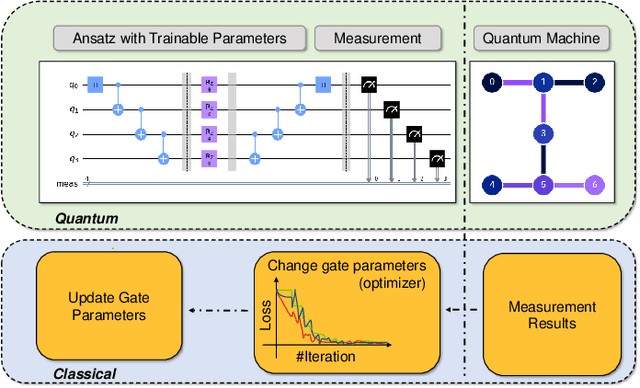
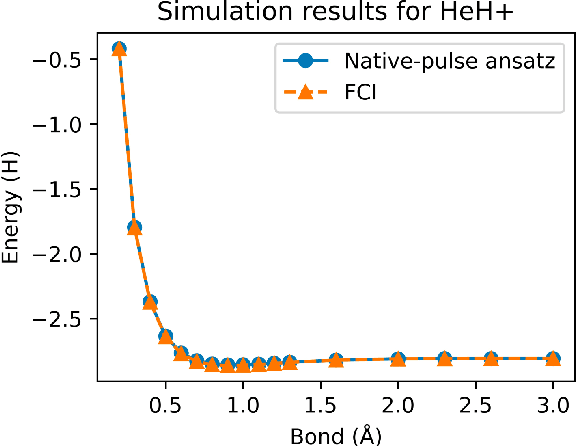
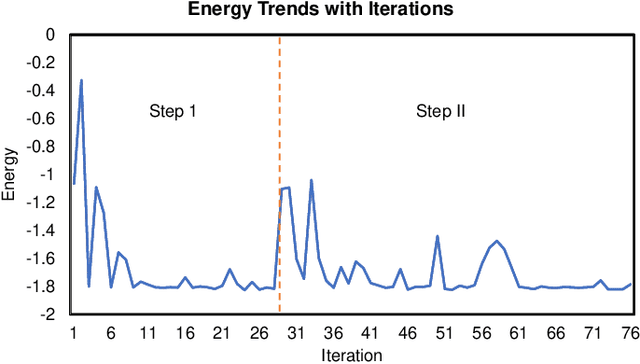

Abstract:Variational quantum algorithms (VQAs) have demonstrated great potentials in the NISQ era. In the workflow of VQA, the parameters of ansatz are iteratively updated to approximate the desired quantum states. We have seen various efforts to draft better ansatz with less gates. In quantum computers, the gate ansatz will eventually be transformed into control signals such as microwave pulses on transmons. And the control pulses need elaborate calibration to minimize the errors such as over-rotation and under-rotation. In the case of VQAs, this procedure will introduce redundancy, but the variational properties of VQAs can naturally handle problems of over-rotation and under-rotation by updating the amplitude and frequency parameters. Therefore, we propose PAN, a native-pulse ansatz generator framework for VQAs. We generate native-pulse ansatz with trainable parameters for amplitudes and frequencies. In our proposed PAN, we are tuning parametric pulses, which are natively supported on NISQ computers. Considering that parameter-shift rules do not hold for native-pulse ansatz, we need to deploy non-gradient optimizers. To constrain the number of parameters sent to the optimizer, we adopt a progressive way to generate our native-pulse ansatz. Experiments are conducted on both simulators and quantum devices to validate our methods. When adopted on NISQ machines, PAN obtained improved the performance with decreased latency by an average of 86%. PAN is able to achieve 99.336% and 96.482% accuracy for VQE tasks on H2 and HeH+ respectively, even with considerable noises in NISQ machines.
GRIM: A General, Real-Time Deep Learning Inference Framework for Mobile Devices based on Fine-Grained Structured Weight Sparsity
Aug 25, 2021



Abstract:It is appealing but challenging to achieve real-time deep neural network (DNN) inference on mobile devices because even the powerful modern mobile devices are considered as ``resource-constrained'' when executing large-scale DNNs. It necessitates the sparse model inference via weight pruning, i.e., DNN weight sparsity, and it is desirable to design a new DNN weight sparsity scheme that can facilitate real-time inference on mobile devices while preserving a high sparse model accuracy. This paper designs a novel mobile inference acceleration framework GRIM that is General to both convolutional neural networks (CNNs) and recurrent neural networks (RNNs) and that achieves Real-time execution and high accuracy, leveraging fine-grained structured sparse model Inference and compiler optimizations for Mobiles. We start by proposing a new fine-grained structured sparsity scheme through the Block-based Column-Row (BCR) pruning. Based on this new fine-grained structured sparsity, our GRIM framework consists of two parts: (a) the compiler optimization and code generation for real-time mobile inference; and (b) the BCR pruning optimizations for determining pruning hyperparameters and performing weight pruning. We compare GRIM with Alibaba MNN, TVM, TensorFlow-Lite, a sparse implementation based on CSR, PatDNN, and ESE (a representative FPGA inference acceleration framework for RNNs), and achieve up to 14.08x speedup.
FORMS: Fine-grained Polarized ReRAM-based In-situ Computation for Mixed-signal DNN Accelerator
Jun 16, 2021



Abstract:Recent works demonstrated the promise of using resistive random access memory (ReRAM) as an emerging technology to perform inherently parallel analog domain in-situ matrix-vector multiplication -- the intensive and key computation in DNNs. With weights stored in the ReRAM crossbar cells as conductance, when the input vector is applied to word lines, the matrix-vector multiplication results can be generated as the current in bit lines. A key problem is that the weight can be either positive or negative, but the in-situ computation assumes all cells on each crossbar column with the same sign. The current architectures either use two ReRAM crossbars for positive and negative weights, or add an offset to weights so that all values become positive. Neither solution is ideal: they either double the cost of crossbars, or incur extra offset circuity. To better solve this problem, this paper proposes FORMS, a fine-grained ReRAM-based DNN accelerator with polarized weights. Instead of trying to represent the positive/negative weights, our key design principle is to enforce exactly what is assumed in the in-situ computation -- ensuring that all weights in the same column of a crossbar have the same sign. It naturally avoids the cost of an additional crossbar. Such weights can be nicely generated using alternating direction method of multipliers (ADMM) regularized optimization, which can exactly enforce certain patterns in DNN weights. To achieve high accuracy, we propose to use fine-grained sub-array columns, which provide a unique opportunity for input zero-skipping, significantly avoiding unnecessary computations. It also makes the hardware much easier to implement. Putting all together, with the same optimized models, FORMS achieves significant throughput improvement and speed up in frame per second over ISAAC with similar area cost.
HASCO: Towards Agile HArdware and Software CO-design for Tensor Computation
May 04, 2021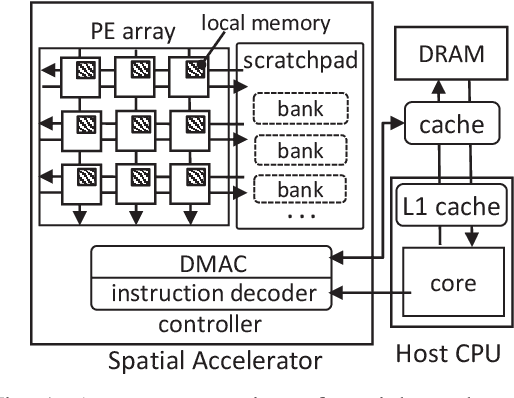

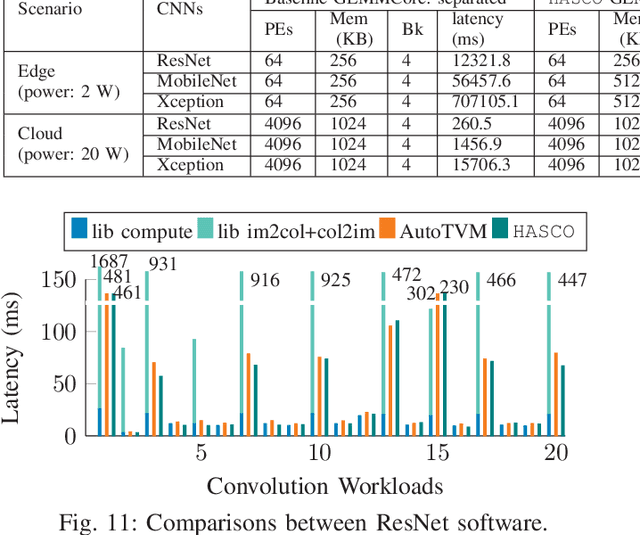
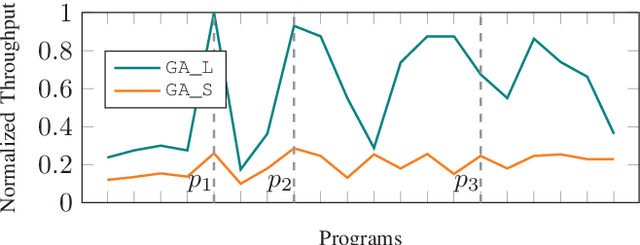
Abstract:Tensor computations overwhelm traditional general-purpose computing devices due to the large amounts of data and operations of the computations. They call for a holistic solution composed of both hardware acceleration and software mapping. Hardware/software (HW/SW) co-design optimizes the hardware and software in concert and produces high-quality solutions. There are two main challenges in the co-design flow. First, multiple methods exist to partition tensor computation and have different impacts on performance and energy efficiency. Besides, the hardware part must be implemented by the intrinsic functions of spatial accelerators. It is hard for programmers to identify and analyze the partitioning methods manually. Second, the overall design space composed of HW/SW partitioning, hardware optimization, and software optimization is huge. The design space needs to be efficiently explored. To this end, we propose an agile co-design approach HASCO that provides an efficient HW/SW solution to dense tensor computation. We use tensor syntax trees as the unified IR, based on which we develop a two-step approach to identify partitioning methods. For each method, HASCO explores the hardware and software design spaces. We propose different algorithms for the explorations, as they have distinct objectives and evaluation costs. Concretely, we develop a multi-objective Bayesian optimization algorithm to explore hardware optimization. For software optimization, we use heuristic and Q-learning algorithms. Experiments demonstrate that HASCO achieves a 1.25X to 1.44X latency reduction through HW/SW co-design compared with developing the hardware and software separately.
Mix and Match: A Novel FPGA-Centric Deep Neural Network Quantization Framework
Dec 12, 2020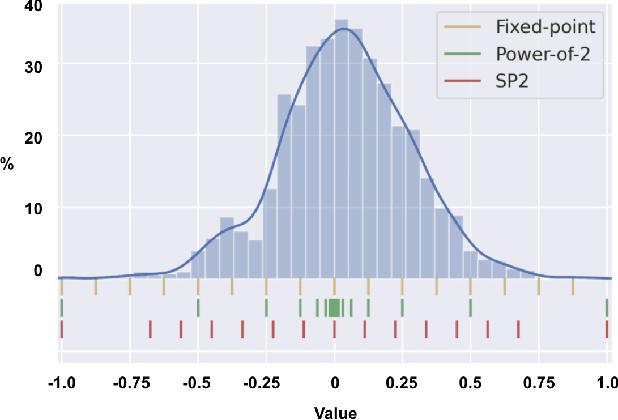
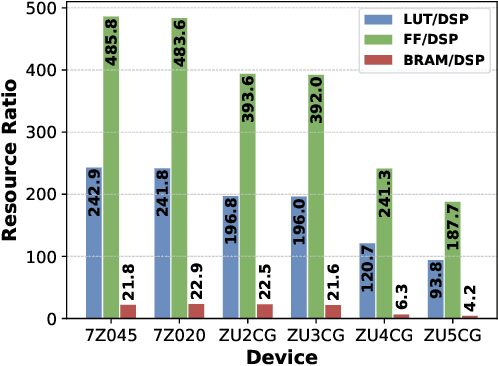
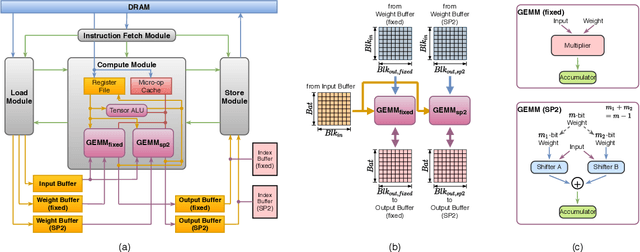
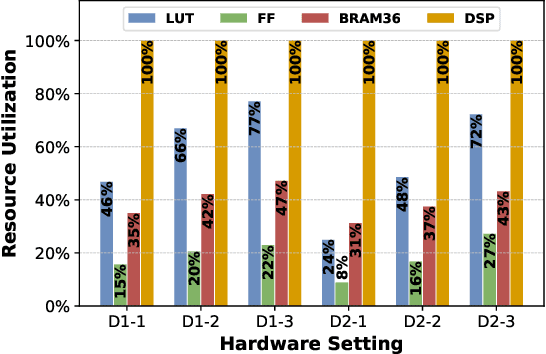
Abstract:Deep Neural Networks (DNNs) have achieved extraordinary performance in various application domains. To support diverse DNN models, efficient implementations of DNN inference on edge-computing platforms, e.g., ASICs, FPGAs, and embedded systems, are extensively investigated. Due to the huge model size and computation amount, model compression is a critical step to deploy DNN models on edge devices. This paper focuses on weight quantization, a hardware-friendly model compression approach that is complementary to weight pruning. Unlike existing methods that use the same quantization scheme for all weights, we propose the first solution that applies different quantization schemes for different rows of the weight matrix. It is motivated by (1) the distribution of the weights in the different rows are not the same; and (2) the potential of achieving better utilization of heterogeneous FPGA hardware resources. To achieve that, we first propose a hardware-friendly quantization scheme named sum-of-power-of-2 (SP2) suitable for Gaussian-like weight distribution, in which the multiplication arithmetic can be replaced with logic shifter and adder, thereby enabling highly efficient implementations with the FPGA LUT resources. In contrast, the existing fixed-point quantization is suitable for Uniform-like weight distribution and can be implemented efficiently by DSP. Then to fully explore the resources, we propose an FPGA-centric mixed scheme quantization (MSQ) with an ensemble of the proposed SP2 and the fixed-point schemes. Combining the two schemes can maintain, or even increase accuracy due to better matching with weight distributions.
PERMDNN: Efficient Compressed DNN Architecture with Permuted Diagonal Matrices
Apr 23, 2020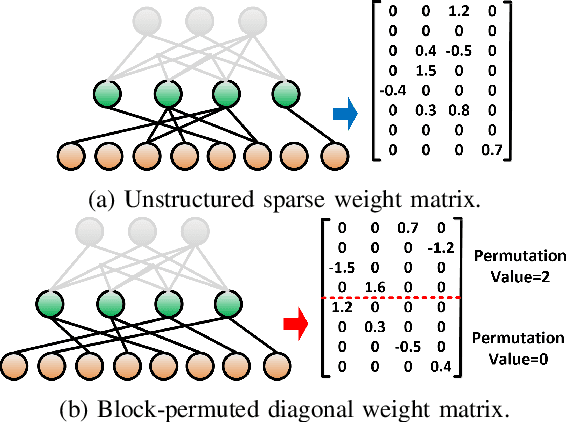
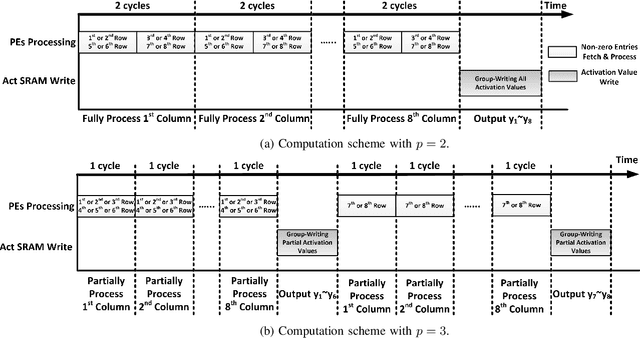
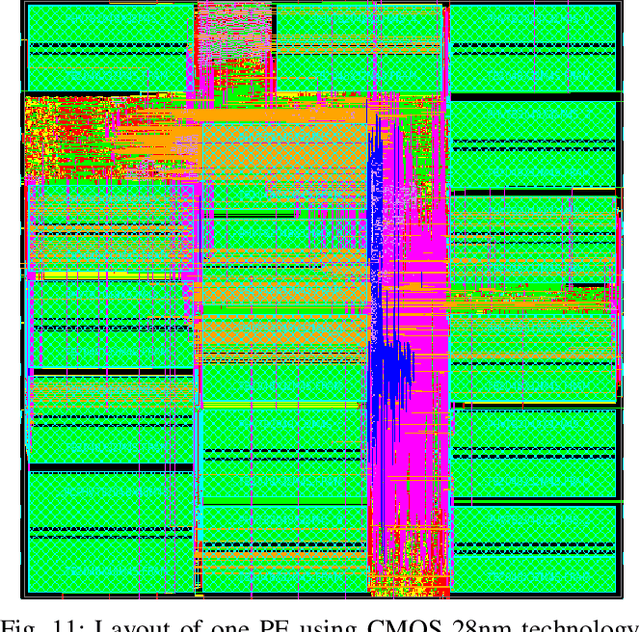

Abstract:Deep neural network (DNN) has emerged as the most important and popular artificial intelligent (AI) technique. The growth of model size poses a key energy efficiency challenge for the underlying computing platform. Thus, model compression becomes a crucial problem. However, the current approaches are limited by various drawbacks. Specifically, network sparsification approach suffers from irregularity, heuristic nature and large indexing overhead. On the other hand, the recent structured matrix-based approach (i.e., CirCNN) is limited by the relatively complex arithmetic computation (i.e., FFT), less flexible compression ratio, and its inability to fully utilize input sparsity. To address these drawbacks, this paper proposes PermDNN, a novel approach to generate and execute hardware-friendly structured sparse DNN models using permuted diagonal matrices. Compared with unstructured sparsification approach, PermDNN eliminates the drawbacks of indexing overhead, non-heuristic compression effects and time-consuming retraining. Compared with circulant structure-imposing approach, PermDNN enjoys the benefits of higher reduction in computational complexity, flexible compression ratio, simple arithmetic computation and full utilization of input sparsity. We propose PermDNN architecture, a multi-processing element (PE) fully-connected (FC) layer-targeted computing engine. The entire architecture is highly scalable and flexible, and hence it can support the needs of different applications with different model configurations. We implement a 32-PE design using CMOS 28nm technology. Compared with EIE, PermDNN achieves 3.3x~4.8x higher throughout, 5.9x~8.5x better area efficiency and 2.8x~4.0x better energy efficiency on different workloads. Compared with CirCNN, PermDNN achieves 11.51x higher throughput and 3.89x better energy efficiency.
 Add to Chrome
Add to Chrome Add to Firefox
Add to Firefox Add to Edge
Add to Edge